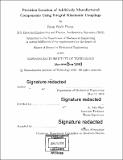Precision location of additively manufactured components using integral kinematic couplings
Author(s)
Penny, Ryan Wade
DownloadFull printable version (12.19Mb)
Other Contributors
Massachusetts Institute of Technology. Department of Mechanical Engineering.
Advisor
A. John Hart.
Terms of use
Metadata
Show full item recordAbstract
Additive manufacturing (AM), commonly known as 3D printing, refers to an increasingly popular set of manufacturing technologies, broadly characterized by selectively adding material to create a component. The benefits of AM include immense design flexibility, the ability to fabricate freeform geometries inaccessible to conventional techniques, and minimal setup and tooling costs, enabling economic production in low quantities. However, all manufacturing techniques have process limitations; commercially viable AM is specifically challenged in achieving accurate form and feature placement, as well as fine surface finishes. This necessitates machining of AM components to achieve tight tolerances, and impedes the ues of as-printed components in precision assemblies. In this thesis, integral kinematic couplings (KCs) are shown to provide precision location of AM components. Maxwell KCs are fabricated using four common AM processes for characterization of their accuracy, repeatability, and stiffness. Modest plastic deformation at the locations of (point) contact between the KC interfaces is shown to average the as-printed surface texture, thereby enabling repeatability on the order of 10 microns. Experimental results are distilled into design rules for application of AM KCs in precision machine design and work holding, including consideration of kinematic geometry, preload, and component characteristics. Finally, application of these guidelines is demonstrated in precision location of optical components, specifically in the construction of a modular Keplerian telescope and modular imaging spectrometer.
Description
Thesis: S.M., Massachusetts Institute of Technology, Department of Mechanical Engineering, 2018. Cataloged from PDF version of thesis. Includes bibliographical references (pages 105-109).
Date issued
2018Department
Massachusetts Institute of Technology. Department of Mechanical EngineeringPublisher
Massachusetts Institute of Technology
Keywords
Mechanical Engineering.